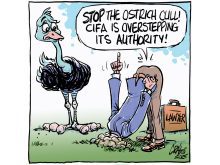Ian Wishart, president of Keystone Agricultural Producers, responds to an opinion piece published in the Aug. 5 issue entitled ‘Fewer regulations will help rail service’.
I would like to take this opportunity to respond to the (above noted) opinion piece inThe Western Producer,which echoes the content of a July 7 letter to minister of agriculture Gerry Ritz, the minister of transport at the time John Baird, and minister of state (transport) Rob Merrifield.
The authors declare their opposition to the call that Keystone Agricultural Producers and other farm groups have been making for a review of the methodology that the Canadian Transportation Agency uses to calculate the maximum revenue that CN Rail and CP Rail can generate from the shipment of western Canadian grain.
Read Also

Rural communities can be a fishbowl for politicians, reporter
Western Producer reporter draws comparisons between urban and rural journalism and governance
For those who know and have worked with the authors, it is not surprising that these individuals share this position given their history with strong, fiscally conservative organizations that generally oppose government intervention whenever possible.
They are entitled to express their opinions in a public forum and I thank them for doing so and calling the issue to attention. Apathy from those affected can be the most difficult hurdle to overcome when developing good public policy.
However, it must be clear that ongoing debate about this issue is not an excuse for government inaction.
We know that when politically difficult decisions need to be made, government often excuses itself from dealing with the issue by claiming there are divisive positions from within our industry, regardless of how limited the vocal opposition is.
I won’t debate the authors’ point that the results of the Estey report and repealing the Western Grain Transportation Act has had positive impacts on our industry through expanded market access.
I do, however, disagree with the statement the authors make that a review of the costing mechanism within the revenue cap will “herald a return to the type of regulation of grain freight rates that was the centrepiece of a half century of failure.”
I truly think the authors should have a more genuine fear of Chairman Mao rising from the dead and being elected premier of Alberta than western Canada returning to a regulatory system that resembles the Crow Rate.
There is no basis for this type of claim to be made.
A costing review is not new regulation. It does little more than acknowledge that the business of moving grain out of the Prairies has changed over the past 20 years since it was determined what a fair and reasonable return on railway investment in their operations should be.
The authors also argue that “commercial discipline and real competitiveness” should be encouraged to solve service failures.
Unfortunately, this solution is a better theory than a realistic alternative to the revenue cap at this time.
Encouraging competition in an industry with immense initial infrastructure costs acting as a barrier to market entry is nearly impossible without substantial government assistance, like that which both CN and CP benefitted from during their inception.
During the Kroeger process, it was suggested that the railways could be forced to offer running rights on their lines to other companies to introduce market competition.
However, there was a reason the Kroeger steering committees decided against this option and why the group that monitors the grain handling and transportation system, most shippers and the railways themselves still don’t want running rights implemented.
Simply put, the logistical nightmare of trying to co-ordinate more companies’ operations on existing lines would be a disaster.
Using the revenue cap to simulate a competitive marketplace is the best available option to protect captive grain shippers.
The future of the grain handling and transportation system in Western Canada will continue to be defined by the market power imbalance that occurs when you have tens of thousands of farmers captive to only two railway companies.
A revenue cap costing review needs to be done to bring the regulatory system we have up to date.
It is an urgent issue that is costing individual farmers thousands of dollars every year.
The debate about how we can improve our industry must continue.
However, allowing monopolistic firms to abuse their market position while this occurs is not an option western Canadian farmers are willing to tolerate.














